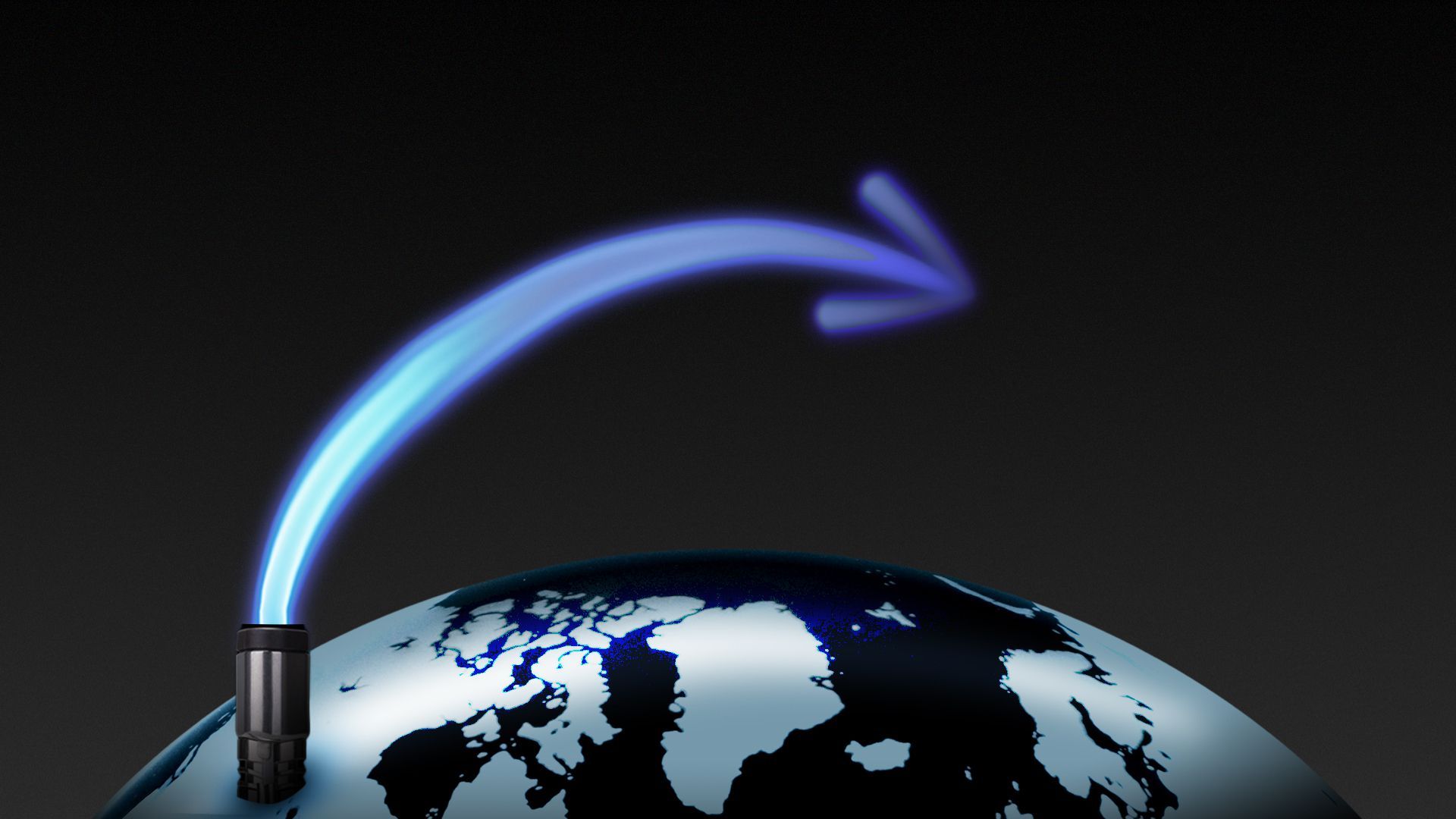| | | | | | | | | | | Axios Generate | | By Ben Geman and Andrew Freedman ·Mar 25, 2022 | | 🍺 Friday is here! Today's Smart Brevity count is 1,262 words, 5 minutes. ⚡ The Axios Pro Climate Deals newsletter launched this week and it's stuffed with must-read coverage. Sign up here. 🚨 Follow Axios' live updates on the war in Ukraine. | | | | | | 1 big thing: Biden's careful embrace of U.S. gas for Europe |  | | | Illustration: Annelise Capossela/Axios | | | | The White House is looking to thread a policy needle by embracing more U.S. liquefied natural gas shipments to Europe while insisting it's not backing off its commitment to fighting climate change, Ben writes. Driving the news: This morning U.S. and European leaders announced a task force on helping to cut the EU's heavy reliance on Russian fossil fuels. - The broad outline calls for U.S. work with "international partners" to find another 15 billion cubic meters of LNG this year.
- Longer-term, it calls for "additional" EU imports of roughly 50 bcm annually of U.S. LNG until at least 2030.
- However, it does not define what "additional" means with respect to existing volumes.
Context: U.S. LNG shipments to Europe grew to over 22 bcm last year, per European Commission data, and have been rising sharply in 2022 as well. The intrigue: The U.S.-European plan aims for energy security and addressing climate change. - Officials vowed to work together on cutting gas demand with renewables, hydrogen, heat pumps, efficiency and more.
- It vows to lessen the greenhouse gas footprint of new LNG infrastructure and pipelines.
The big picture: It comes as the EU is already looking to greatly cut Russian oil, gas and coal imports through diversification but also faster clean energy deployment and better efficiency. Officials there are crafting a proposal to seek to end that reliance by 2027. Russia provides about 40% of Europe's gas and 25% of its oil. Yes, but: Biden is already facing pushback from environmentalists. "Permitting construction of any new fossil fuel infrastructure would lock America into decades of ongoing reliance on fossil fuels that is incompatible with President Biden's climate goals," Evergreen Action's Jamal Raad said in a statement. There are other uncertainties too. LNG flows are based on market conditions and constraints on how quickly total volumes can increase beyond what's already planned. |     | | | | | | 2. What they're saying: the U.S.-EU energy deal | | "This crisis also presents an opportunity. It's a catalyst...that will drive the investments we need to double down on our clean energy goals and accelerate towards a net-zero future," President Biden said in Brussels this morning at a press event with European Commission President Ursula von der Leyen. State of play: Nikos Tsafos, a gas market expert with the Center for Strategic and International Studies, notes a large share of U.S. LNG already goes to Europe. - The U.S., Qatar and Australia are the world's biggest suppliers, and European buyers compete for supplies with energy-hungry countries in Asia.
- "You can shuffle gas around, but it's costly and it's not a permanent fix," Tsafos said. "We have to talk about adding supply, not just rearranging flows."
- But infrastructure takes years to build and those investments assume long-term exports, even as the framework with Europe has a 2030 horizon. "That's not a signal for new investment," he said via email.
Zoom in: A separate joint U.S.-European Commission statement this morning provides a few more details. It says the EC will support "long-term contracting mechanisms" and work with the U.S. to "encourage relevant contracting" to back investment in new export and import infrastructure. |     | | | | | | 3. Research corner: big methane leaks | | Source: Giphy Speaking of natural gas, new research shows that methane leaks from a major U.S. oil-and-gas producing region are far higher than prior estimates, Ben writes. Why it matters: Methane, the main component of natural gas, is a powerful planet-warming substance. Leaks in production and transport erode — or could even erase — benefits of much lower CO2 emissions than coal when the fuels are burned for power. Driving the news: The Stanford-led study in Environmental Science & Technology used sophisticated airborne imaging to analyze leaks on the New Mexico side of the prolific Permian Basin region. - The topline finding is a leak rate of over 9% of gas produced (though they also offer a range of estimates).
- That's "several-fold higher than Environmental Protection Agency estimates and well above those in the published literature," a Stanford summary notes.
- "It's worse than we thought by a long shot," co-lead author Evan Sherwin said in a statement, and in an email, he notes that's far above the amount that nullifies the climate advantage over coal.
How it works: The survey involved over 100 flights between 2018-2020, covering roughly 14,000 square miles, over 26,000 wells and thousands of miles of pipelines, per the study and a Stanford summary. Yes, but: One bright spot is that a relatively small number of "super-emitter" sites have an outsized impact on the region's total emissions, with less than 4% comprising over half the total. "Once leaks are identified, shutting them down is often an inexpensive and straightforward fix," the summary notes. It also comes as oil-and-gas producers have been boosting focus on curbing methane emissions. |     | | | | | | A message from Chevron | | The fuels of the future can come from anywhere | | |  | | | | Chevron is exploring unexpected sources of energy to help create a lower carbon future. We're working with partners in California to convert the methane from cow waste into renewable natural gas that, one day, can help fuel trucks across the nation. Because it's only human to keep innovating. | | | | | | 4. Manchin's return to the climate bill table |  | | | Photo illustration: Aïda Amer/Axios. Photo: Kevin Dietsch/Getty Images | | | | Sen. Joe Manchin (D-W.Va.) told a group of climate activists and energy executives he's open to supporting revised Build Back Better legislation narrowly addressing three topics: climate, drug prices and deficit reduction, Hans Nichols reports. Why it matters: Manchin's private comments during a closed-door dinner Monday are a clear indication he's serious about returning to the negotiating table, but for a much smaller version of President Biden's initial $3.5 trillion proposal, people familiar with the matter tell Axios. - His remarks at the dinner hosted by the American Clean Power Association, the trade association for the renewable energy industry, are consistent with conversations Manchin has had with Senate colleagues.
- In those informal talks, he's outlined a deal that includes roughly $500 billion for climate and $1 trillion in new revenue.
The intrigue: The Washington Post, which also has coverage of Manchin restarting talks with Democratic colleagues, reports that Biden administration officials are seeking oil-and-gas policies "that could make the measure more palatable to him." |     | | | | | | 5. Home EV charging isn't easy for many |  Data: Morning Consult; Chart: Baidi Wang/Axios Potential electric vehicle buyers are told not to worry so much about access to public charging stations because most people will charge their EVs at home. But many people say they don't have EV charging available where they live, Joann Muller reports. Driving the news: 78% of U.S. adults surveyed by Morning Consult said there is no EV charging access at home where their vehicles are parked. Yes, but: Respondents weren't asked whether they have an ordinary electrical outlet in their garage or near their driveway, which is all that's needed to plug in an EV. (A dedicated charger is faster, but isn't necessary.) - That was by design, explains mobility analyst Lisa Whalen, who authored Morning Consult's State of Automotive and Mobility report.
- "It just shows the disconnect in the education of the public" about charging, she said.
What they found: Only 11% of adults report that charging is always available at home. Access was higher on the East and West Coasts (19% for each) and among higher-income households. The bottom line: If you don't have a garage or a dedicated parking spot, your charging access is likely limited, which could potentially stunt EV growth. What's needed: Manufacturers, tech providers and policymakers need to make home charging easier. |     | | | | | | 6. Catch up fast: FERC, batteries, renewables | | Policy: "Amid pushback from industry groups and lawmakers in both parties, federal energy regulators on Thursday scaled back plans to consider how natural gas projects affect climate change and environmental justice." (Associated Press) Deals: Japanese trading house Mitsui has agreed to invest 575 million euros ($631 million) for a 27.5% stake in Mainstream Renewable Power, a company controlled by Norway's Aker Horizons, the companies said on Thursday." (Reuters) Manufacturing: "LG Energy Solution, a supplier for electric car makers Tesla and Lucid, said on Thursday in Korea it plans to invest 1.7 trillion Korean won ($1.4 billion) to build a battery factory in Arizona by 2024 to meet demand from "prominent startups" and other North American customers." (Reuters) |     | | | | | | A message from Chevron | | The fuels of the future can come from anywhere | | |  | | | | Chevron is exploring unexpected sources of energy to help create a lower carbon future. We're working with partners in California to convert the methane from cow waste into renewable natural gas that, one day, can help fuel trucks across the nation. Because it's only human to keep innovating. | | |  | It's called Smart Brevity®. Over 200 orgs use it — in a tool called Axios HQ — to drive productivity with clearer workplace communications. | | | | | | Axios thanks our partners for supporting our newsletters. If you're interested in advertising, learn more here.
Sponsorship has no influence on editorial content. Axios, 3100 Clarendon Blvd, Suite 1300, Arlington VA 22201 | | | You received this email because you signed up for newsletters from Axios.
Change your preferences or unsubscribe here. | | | Was this email forwarded to you?
Sign up now to get Axios in your inbox. | | | | Follow Axios on social media:    | | | | | |
No comments:
Post a Comment